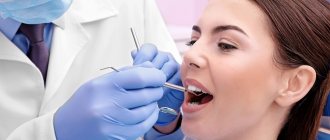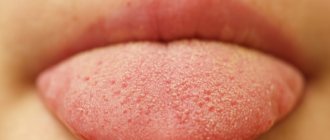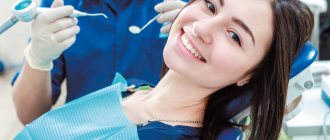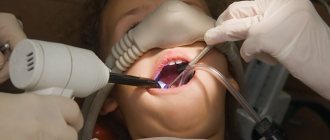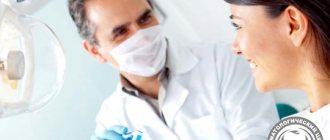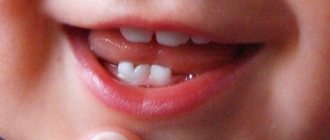At the first visit, it is important for each patient to receive detailed information about his disease, its causes, consequences, methods of treatment and prevention. The total cost of treatment is also important information for the patient. In order to answer these questions, the doctor conducts an initial examination and diagnosis and, based on their results, develops a treatment plan.
What happens from the time you arrive at the clinic until you receive your treatment plan? View the standard treatment plan that our specialists draw up for patients.
At the first visit, the patient meets his attending physician and expresses his complaints. The doctor studies the noted problem and carries out a number of diagnostic measures. In simple cases, a minimum set of diagnostic measures is required.
What does the dentist do during the examination?
If there are no complaints, the initial examination proceeds according to the standard plan.
Visual assessment. The doctor examines the crowns, gums, mucous membranes (inner surface of the lips, cheeks), palate, checking:
- the presence of soft plaque and hard deposits on the enamel and in the gum pockets. Tartar accumulation indicates ineffective hygiene and requires professional cleaning. It is removed to check that there are no demineralized areas or caries underneath;
- general condition of the enamel: its color, transparency, gloss, presence or absence of mechanical defects. During examination, the doctor can identify chips, wedge-shaped defects, erosion, demineralization;
- signs of gum inflammation: swelling, discoloration, thickened areas, ulcers, etc.;
- condition of the mucous membranes (assessment of symptoms of gingivitis, traces of frequent mechanical injuries, burns, irritation or inflammation);
- condition of the palate, tongue (signs of injury, plaque deposits, traces of inflammation, erosion).
The color of the enamel is assessed separately. Its changes may indicate pulpitis (becomes gray), the use of certain medications (the shade changes to yellow or pink, may require bleaching), demineralization or caries in the stage of a white or dark spot (enamel lightens, loses its gloss, and then darkens, may turn brown or almost black).
Probing. It is carried out to control the strength of the enamel and evaluate the surface of the crowns. For this, a special tool is used - a probe. Such diagnostics allows us to identify caries, determine its stage, and the degree of tooth destruction. Probing also helps to diagnose non-carious lesions: fluorosis, hypoplasia, enamel erosion. It is carried out both for healthy and already filled teeth. If the crown has been restored, using a probe you can identify secondary caries and assess the condition of the fissures on the chewing surfaces. The tool should be blunt, angular, with a notch at the end. Probing is painless: the dentist simply runs a blunt end over the surface of the crowns, assessing the smoothness or roughness of the enamel and the degree of its hardness. The same technique is used to control gum pockets. The end of the probe is inserted into the groove behind the edge of the gum on all four sides of the crown. The immersion depth of the tool should not exceed 1 mm. If it goes deeper, the gum pocket is enlarged and this may indicate periodontal disease.
Using a probe, the gaps between your own tissues and the edges of the fillings are additionally checked. If they are enlarged (there is a noticeable joint that can be felt when the instrument is passed over the crown), this may require retreatment. When probing, the doctor can detect softening of dentin under the chewing surface, deposits of tartar on the neck of the tooth, under the gingival margin.
Palpation. It is carried out to assess the condition of the periodontium and identify hidden inflammation. With this diagnosis, the tooth is moved with tweezers in different directions, assessing its movement in the alveolus and how much it can move. If even with a slight force the crown moves, this indicates inflammation and swelling of the tissue. They can occur after injury, with periodontitis, periodontal disease, and periodontitis.
Additionally, they check in which directions the crown moves (only in one, two, three, in any direction, vertically, with the possibility of rotation, scrolling around the axis). When performing palpation, the doctor evaluates the patient’s sensations (is there any pain, sensitivity, during which movement of the crown is the pain most intense). When the tooth is rocked, bloody or purulent discharge may appear; the doctor may detect swelling or compaction, and this also helps to make a diagnosis. Traditional palpation (palpation) is carried out for the gums, inner surface of the cheeks and lips, if inflammation or other pathology is suspected.
Percussion. This is tapping the crowns with a probe handle or tweezers. The movements should be light, each tooth is tapped on the sides and on the top surface. The appearance of pain with a horizontal blow may indicate periodontitis, with a vertical blow it may indicate inflammation of the nerve or pulpitis. By assessing during percussion exactly in which places, during which tapping pain appears, and how severe it is, the doctor can make a preliminary diagnosis.
In some cases, radiography may be required during the initial examination. It helps to assess the condition of bone tissue, roots, and the filling density of the root canals if the tooth has already been filled.
What diseases does the dentist treat?
A dentist, depending on his specialization, can diagnose and treat the following pathologies:
- Therapist , including a pediatric dentist - superficial or deep caries, pulpitis and periodontitis, incorrect or untimely teething.
- Hygienist – removes pigmentation of tooth enamel and also removes mineralized or soft plaque.
- Orthopedist – deals with aesthetic dental restoration, implantation and prosthetics. Treats any violations of the integrity of the dentition or individual teeth that cannot be corrected with standard filling. These are cracks, chips, erosion of tooth enamel, partial or complete destruction of the tooth crown, irregularities in the shape, size, and location of teeth. An orthopedist can restore the chewing and sound-producing function of teeth, regardless of how many elements of the dentition are missing, removed or damaged - one or all.
- Orthodontist – deals with the correction of malocclusion in children and adults, and also performs preventive prosthetics in children.
- Surgeon - this specialist removes those teeth that cannot be restored, and also treats damage to the soft tissues of the oral cavity and congenital or acquired pathologies of the dentofacial system that require surgical intervention.
- Periodontist – deals with gum diseases. The doctor treats gingivitis (catarrhal, ulcerative-necrotic, hypertrophic), periodontitis, periodontal disease.
The dentist can also give recommendations and prescribe treatment in case of infectious and inflammatory diseases of the oral cavity - stomatitis, candidiasis.
The doctor talks about the peculiarities of the work of a pediatric dentist in the following video:
to contents ^
Dentist consultation
It is carried out in two stages. Before the examination begins, the doctor talks with the patient, interviews him, collects information about existing complaints, previous treatment, the presence of concomitant or systemic diseases, possible contraindications for certain treatment methods. The goal is to collect general information about your health status.
The second stage of consultation is carried out after the examination. The dentist talks about identified dental problems, offers treatment options, and schedules the next appointment. If the appointment was preventive and the patient is healthy, the doctor can give recommendations on dental care and set a date for the next examination (usually every six months or more often if there are indications for this).
How to prepare your child for a trip to the dentist: 7 important rules
Taking your child for the first time to the dentist is a serious and important event in the life of a young family. All fears come from our childhood, because it is known that the cause of dental phobia in most adults is an unsuccessful experience with dental treatment in the past. That is why it is very important that the first meeting with the doctor goes well and does not leave an unpleasant typo in the child’s memory, which can then transform into a fear of dentistry. Let's look at some important tips that will help parents prepare their baby for the first visit to the dentist:
— Do not put off going to the Virtuoso dental clinic until your child has real problems with his teeth. The optimal age for the first meeting with a dentist is one to two years. During the first visit to the dentist, the child will explore the environment and get to know the doctor. The dentist will also conduct a preventive examination - look at the condition of the teeth and gums, whether they are growing correctly, and whether there are any caries. Even if the examination reveals any problems with the teeth, treatment should be postponed until the next visit. This way, the baby will have only positive memories of dentistry, and next time he will agree to go to the doctor without any problems. You should visit the dentist with your child once every six months. This way he will get used to systematic visits and will not be afraid of treatment in the future, and you will be able to prevent the formation of caries or other possible problems with teeth.
— It should be understood that initially the child has no fear of dental treatment, because he does not know what awaits him in the dental clinic. In most cases, this fear is instilled in the child by parents without noticing it themselves. Don't make this common mistake. To do this, first of all you need to calm down. If a child feels the fear of his parents, this state will be transmitted to him. Also, you should not focus on the importance and unpleasantness of the event, so the baby will not be nervous.
— A good way to prepare your child for going to the dental clinic is to play “dentist” with him at home. Treat the teeth of a bunny or doll, and while playing, tell them what manipulations the doctor performs and how to behave in the dental office. The story should be interesting, exciting and not scary. When talking about dentistry, do not use words that may scare the baby. It is better to replace such words with simpler and understandable ones for the baby. This way the child will have an idea of what awaits him in the dentist’s office.
— The situation when a child has never been to the dentist, and the tooth is already sick, is, of course, more complicated. Under no circumstances should you deceive your child and say that “it won’t hurt” if the treatment is going to be painful. So the baby will experience stress not only from visiting the dentist, but also from deceiving his parents. In the future, it will be difficult to earn the child’s trust. It is better to honestly say that “it will be a little unpleasant, but he will cope with it.” Be sure to smooth out this recognition with a story about a pleasant event that awaits the baby after visiting the doctor.
— On the day of visiting the dentist, the child should get enough sleep and be in a good mood. Be sure to feed your baby well before going to the clinic, especially if he is undergoing treatment. After all, after visiting a doctor, you will not be able to eat for at least two to three hours.
— If a child was capricious and a trip to the dentist had to be postponed, there is no need to scold the child. It is better to talk to him calmly, find out his fears regarding a visit to the doctor, and try to dispel them. If the child behaved well and the visit to the dentist went well, be sure to praise the child and reward him with some small gift. The baby will certainly be pleased with this, and next time he will go to the clinic more willingly.
— Of course, it is very important to choose a good dental clinic and an experienced pediatric dentist. For the first meetings of a child with a doctor, it is better to opt for a private dentistry with a specially equipped office for children. In such a clinic, much attention is paid to the environment in the children's office; they are colorful and cozy, the child will be interested and not afraid to be in it. Doctors in private clinics, as a rule, are more friendly and communicate better with young patients.
in Voronezh - a high-quality dental clinic, recognized as the best in the city. One of the nominations in which “Virtuoso” dentistry won the prestigious “LUX-TIME” award was “Children’s Doctor”. This allows us to confidently recommend this clinic for children. The best reward for parents is a happy, healthy smile for their child, so make an appointment with the dentist now!
First visit to the pediatric dentist - how to put your child in a positive mood
Caries is considered one of the most common dental diseases, affecting the vast majority of children. According to statistics, carious cavities occur in 80% of all children in Russia1. The first visit to the dentist is an important event, the success of which directly determines the child’s future attitude towards dental treatment. Experts in this field insist that your baby should make an appointment with a specialist immediately after the first teeth erupt. Read on in our article to learn how to prepare for this difficult test, especially if your child is afraid of the dentist.
How to arrange a child's visit to the dentist
Useful tips for parents:
- Make an appointment in the morning so that your child does not have a reason to worry all day about the upcoming visit. In addition, young children are usually calmer in the morning,
- One parent is sufficient to accompany the child to the clinic. Bring your baby's favorite book or toy with you. While waiting, he can be distracted by reading, looking at pictures or, for example, playing a game.
- Before going on a hike, it is also advisable that the child is well-rested and does not have colds or other diseases. If this happens on the day of your planned visit to a specialist, then it is better to postpone the visit until better times.



